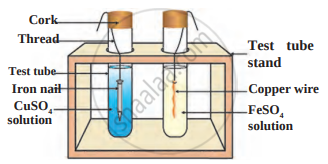Advertisements
Advertisements
प्रश्न
Metal oxides generally react with acids, but few oxides of metal also react with bases. Such metallic oxides are:
- MgO
- ZnO
- Al2O3
- Cao
पर्याय
I and II
II and III
III and IV
I and IV
उत्तर
II and III
Explanation:
Some metal oxides, such as aluminium oxide, zinc oxide shows both acidic as well as basic behaviour. Such metal oxides that react with both acids and bases to produce salt and water are known as amphoteric oxides.
Aluminium oxide reacts with base as follows:
\[\ce{Al2O3 + 2NaOH -> \underset{(Sodium aluminate)}{2NaAlO2} + H2O}\]
ZnO is an oxide that can react with base, as shown by the equation given below:
\[\ce{ZnO + 2NaoH -> Na2ZnO2 + H2O}\]
संबंधित प्रश्न
Give two examples of amphoteric oxides.
Name two metals which will displace hydrogen from dilute acids, and two metals which will not.
What are amphoteric oxides?
Generally, metals react with acids to give salt and hydrogen gas. Which of the following acids does not give hydrogen gas on reacting with metals (except Mn and Mg)?
Stainless steel is very useful material for our life. In stainless steel, iron is mixed with
When a metal X is treated with cold water, it gives a basic salt Y with molecular formula XOH (Molecular mass = 40) and liberates a gas Z which easily catches fire. Identify X, Y and Z and also write the reaction involved.
Answer the questions based on the figure below:

- Which experiment setup is demonstrated in the figure?
- What do you conclude after the reactions? Name reaction.
Keerti added dilute Hydrochloric acid to four metals and recorded her observations as shown in the table given below:
| Metal | Gas Evolved |
| Copper | Yes |
| Iron | Yes |
| Magnesium | No |
| Zinc | Yes |
Select the correct observation(s) and give chemical equation(s) of the reaction involved.
Write a chemical equation showing the ionic products formed on dissolving potassium hydroxide in water.
On adding dilute sulphuric acid to a test tube containing a metal ‘X’, a colourless gas is produced when a burning match stick is brought near it. Which of the following correctly represents the metal ‘X’?
